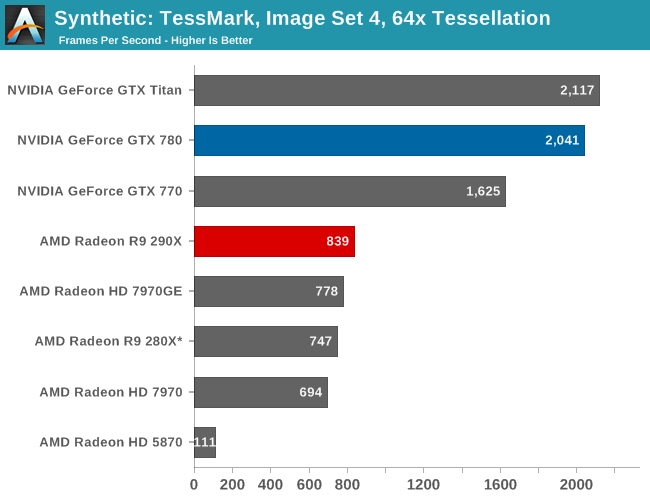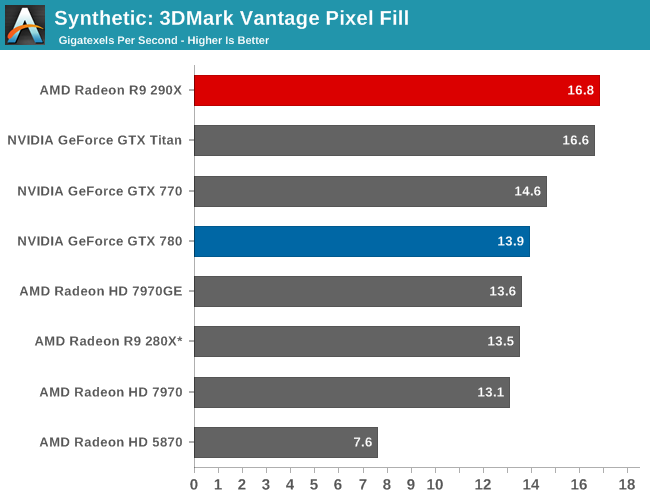The AMD Radeon R9 290X Review
by Ryan Smith on October 24, 2013 12:01 AM EST- Posted in
- GPUs
- AMD
- Radeon
- Hawaii
- Radeon 200
Synthetics
As always we’ll also take a quick look at synthetic performance. The 290X shouldn’t pack any great surprises here since it’s still GCN, and as such bound to the same general rules for efficiency, but we do have the additional geometry processors and additional ROPs to occupy our attention.

Right off the bat then, the TessMark results are something of a head scratcher. Whereas NVIDIA’s performance here has consistently scaled well with the number of SMXes, AMD’s seeing minimal scaling from those additional geometry processors on Hawaii/290X. Clearly Tessmark is striking another bottleneck on 290X beyond simple geometry throughput, though it’s not absolutely clear what that bottleneck is.
This is a tessellation-heavy benchmark as opposed to a simple massive geometry bencehmark, so we may be seeing a tessellation bottleneck rather than a geometry bottleneck, as tessellation requires its own set of heavy lifting to generate the necessary control points. The 12% performance gain is much closer to the 11% memory bandwidth gain than anything else, so it may be that the 280X and 290X are having to go off-chip to store tessellation data (we are after all using a rather extreme factor), in which case it’s a memory bandwidth bottleneck. Real world geometry performance will undoubtedly be better than this – thankfully for AMD this is the pathological tessellation case – but it does serve of a reminder of how much more tessellation performance NVIDIA is able to wring out of Kepler. Though the nearly 8x increase in tessellation performance since 5870 shows that AMD has at least gone a long way in 4 years, and considering the performance in our tessellation enabled games AMD doesn’t seem to be hurting for tessellation performance in the real world right now.
Moving on, we have our 3DMark Vantage texture and pixel fillrate tests, which present our cards with massive amounts of texturing and color blending work. These aren’t results we suggest comparing across different vendors, but they’re good for tracking improvements and changes within a single product family.

Looking first at texturing performance, we can see that texturing performance is essentially scaling 1:1 with what the theoretical numbers say it should. 36% better texturing performance over 280X is exactly in line with the increased number of texture units versus 280X, at the very least proving that 290X isn’t having any trouble feeding the increased number of texture units in this scenario.

Meanwhile for our pixel fill rates the results are a bit more in the middle, reflecting the fact that this test is a mix of ROP bottlenecking and memory bandwidth bottlenecking. Remember, AMD doubled the ROPs versus 280X, but only gave it 11% more memory bandwidth. As a result the ROPs’ ability to perform is going to depend in part on how well color compression works and what can be recycled in the L2 cache, as anything else means a trip to the VRAM and running into those lesser memory bandwidth gains. Though the 290X does get something of a secondary benefit here, which is that unlike the 280X it doesn’t have to go through a memory crossbar and any inefficiencies/overhead it may add, since the number of ROPs and memory controllers is perfectly aligned on Hawaii.










396 Comments
View All Comments
AtwaterFS - Thursday, October 24, 2013 - link
Nice, Nvidia has two choices, drop prices substantially, or drop trou.I certainly hope its the former, as I have no interest in seeing Jen-Hsun's pig in a blanket...
Wreckage - Thursday, October 24, 2013 - link
Not really the Titan slayer we were hoping for.After all this wait and hype it's not surpassing last years GK110. I guess we don't look for big gains in new chips anymore.
The Von Matrices - Thursday, October 24, 2013 - link
This is on the same process node as Titan. Big advances don't happen without process node shrinks, regardless of manufacturer.ninjaquick - Thursday, October 24, 2013 - link
A million times this... GCN is superior to Kepler, and probably Maxwell as well. It doesn't waste tons of die-space on large cache/special decoders/legacy bullshit. Game creators want massive arrays of simple math units that can voraciously crunch numbers, and that is what GCN delivers.EJS1980 - Thursday, October 24, 2013 - link
"GCN is superior to Kepler, and probably Maxwell as well"...HEHEH..... THIS IS PRETTY FUNNY, MAN......THANKS.....I NEEDED THAT! :PWill Robinson - Thursday, October 24, 2013 - link
Yeah right Wreckage...only slayed Titan by about $500 LOLIdiot.
chizow - Thursday, October 24, 2013 - link
Great price and performance from AMD without a doubt, it's not quite a clean sweep but it is certainly a convincing victory for R9 290X, especially at higher resolutions. 780Ti may come close or even exceed 290X, but the damage to Nvidia's product stack has been done.The symmetrical irony here is that this generation's price escalation that began at $550 with AMD's first 28nm part, Tahiti, has come full circle and brought back to balance with AMD's last 28nm part, Hawaii, again at that $550 price point.
I'm happy to see some balance back in the GPU market though, I stated this month's ago at 690 and Titan launch, that this $1K pricing model was an unsustainable business strategy for Nvidia. Now it's going to bite them squarely in the ass. They'll now reap what they sow and have to deal with the angst and anger from all of their most loyal fans who will undoubtedly feel as if they were cheated by the 690, Titan and even 780.
chizow - Thursday, October 24, 2013 - link
I guess it couldn't be all good news though, it looks like the leaked thermals, power consumption and acoustics weren't exaggerated. Definitely loud and hot, with high operating temps. I guess AMD really pushed the GPU to the max, I doubt there will be much more OC headroom, at least with the reference cooler.If Nvidia wasn't so greedy with 690/Titan/780 pricing 290X might've been the next Fermi with mixed reactions, but I'm sure the price and performance will overshadow heat/power concerns.
t41nt3d - Thursday, October 24, 2013 - link
NVIDIA won't be bitten in the ass at all due to the prices of the 690s and Titan. A god awful amount of people have paid $1000 (Including me) for one or more of these cards, and it's taken /8 Months/ for AMD to release a card that goes back and forth with the Titan - Doesn't outright beat it in some games, can go either way.NVIDIA have made a crapload of money from their two overpriced cards and have been reaping off this for a long time now, all they need to do is lower prices and no money lost. It's AMD who's been letting them get away with those prices for so long.
It seems a perfectly viable business strategy for them to have done what they've done and to be so successful at it.
chizow - Thursday, October 24, 2013 - link
I guess we will see, their job just got that much harder to try to sustain this $1000 pricing model now that a $550 card now matches and sometimes outperforms their $1000 card. What kind of performance do you think they're going to need next time to try and justify a $1000 pricetag?Again, Nvidia went down the path of an unsustainable business model predicated on the fact they would be an entire ASIC ahead of AMD. That lead was clearly short-lived due to Kepler's excellent overall performance, but Hawaii brought that dream back down to reality. Sure a bit late, but still in time to crash Nvidia's $1K parade.